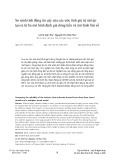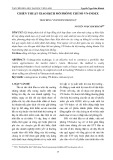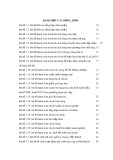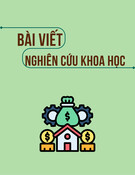
90
Tạp chí Kinh tế - Luật & Ngân hàng
Số 270- Năm thứ 26 (11)- Tháng 10. 2024
© Học viện Ngân hàng
ISSN 3030 - 4199
Ứng dụng phương pháp học máy dự báo mức độ căng
thẳng tài chính của doanh nghiệp niêm yết tại Việt Nam
Ngày nhận: 04/04/2024 Ngày nhận bản sửa: 04/07/2024 Ngày duyệt đăng: 11/07/2024
Tóm tắt: Bài báo sử dụng các phương pháp học máy và phương pháp thống
kê truyền thống để dự báo mức độ căng thẳng tài chính của các doanh nghiệp
niêm yết tại Việt Nam. Dữ liệu sử dụng trong bài báo được thu thập từ 646
doanh nghiệp niêm yết trên hai sàn giao dịch HOSE và HNX trong giai đoạn
2012- 2022. Nghiên cứu tiến hành thử nghiệm bộ dữ liệu thu thập trên các mô
hình học máy: Multiple Regression Model (MRL), LASSO, Generalized Additive
Model (GAM), Random Forests (RF), Gradient Boosting Regression Trees (GBRT),
Predicting financial distress of Vietnamese listed companies using machine learning
Abstract: This study utilizes the traditional statistical method and machine learning methods to forecast
the level of financial distress of listed companies in Vietnam. The data used in the study was collected
from 646 listed companies on the HOSE and HNX exchanges during the period 2012-2022. The study
experiments with the dataset on 6 machine learning models: Multiple Regression Model (MRL), LASSO,
Generalized Additive Model (GAM), Random Forests (RF), Gradient Boosting Regression Trees (GBRT),
and a single-layer, feed-forward neural network (NN), as well as the traditional statistical method. The
research results demonstrate a congruence between the outcomes of the traditional method and modern
machine learning models. Among these, the model with the highest accuracy is Random Forest (RF) with
an accuracy rate of 98.8%. The variables that most influence the financial distress status of companies are
TANG, ROA, LTD, NPM. Based on these results, our study proposes recommendations to support informed
and effective financial decisions for stakeholders (companies, regulatory agencies, shareholders, creditors,
investors).
Keywords: Financial distress, Machine learning, Multiple regression model, LASSO, Generalized additive
model, Random Forests, Gradient Boosting Regression Trees, Neural Network
Doi: 10.59276/JELB.2024.010.2709
Giang, Thi Thu Huyen1, Do, Thi Van Trang2, Doan, Viet Thang3, Hoang, Thi Ngoc Anh4, Nguyen, Thi Hong5,
Le, Duc Minh6, Nguyen, Thi Thanh7, Nguyen, Minh Thuy Tien8
Email: huyengtt@hvnh.edu.vn1, trangdtv@hvnh.edu.vn2, thang.dv509@gmail.com3, hnanh12123@
gmail.com4, nguyenthihong28103@gmail.com5, minhmeo930@gmail.com6, 24a4040378@bav.edu.vn7,
26a4011829@hvnh.edu.vn8
Organization of all: Banking Academy of Vietnam
Giang Thị Thu Huyền1, Đỗ Thị Vân Trang2, Đoàn Viết Thắng3, Hoàng Thị Ngọc Ánh4,
Nguyễn Thị Hồng5, Lê Đức Minh6, Nguyễn Thị Thanh7, Nguyễn Minh Thủy Tiên8
Học viện Ngân hàng, Việt Nam

GIANG THỊ THU HUYỀN - ĐỖ THỊ VÂN TRANG - ĐOÀN VIẾT THẮNG - HOÀNG THỊ NGỌC ÁNH -
NGUYỄN THỊ HỒNG - LÊ ĐỨC MINH - NGUYỄN THỊ THANH - NGUYỄN MINH THỦY TIÊN
91
Số 270- Năm thứ 26 (11)- Tháng 10. 2024- Tạp chí Kinh tế - Luật & Ngân hàng
và Single-layer, Fed-forward neural network (NN) và phương pháp thống kê
truyền thống. Kết quả của nghiên cứu cho thấy có sự phù hợp giữa kết quả
của phương pháp truyền thống và các mô hình học máy hiện đại. Trong đó,
mô hình có độ chính xác cao nhất là Random Forest (RF) với tỉ lệ chính xác
98,8%. Các biến có ảnh hưởng nhiều nhất đến tình trạng căng thẳng tài chính
của doanh nghiệp là TANG, ROA, LTD, NPM. Dựa trên kết quả này, bài báo đề
xuất một số khuyến nghị giúp hỗ trợ ra quyết định tài chính đúng đắn và có
hiệu quả cho các bên liên quan (doanh nghiệp, cơ quan quản lý, cổ đông, chủ
nợ, nhà đầu tư).
Từ khóa: Căng thẳng tài chính, Học máy, Multiple regression model, LASSO,
Generalized additive model, Random Forests, Gradient Boosting Regression
Trees, Neural Network
1. Giới thiệu
Trong bối cảnh kinh tế toàn cầu ngày càng
biến động, việc đánh giá và dự báo mức độ
căng thẳng tài chính của các doanh nghiệp
niêm yết trở nên quan trọng hơn bao giờ
hết. Theo Kaplan và Zingales (1997), một
doanh nghiệp được xem là bị căng thẳng
tài chính khi kinh phí sẵn có, nguồn vốn
bên ngoài cản trở quyết định đầu tư, buộc
doanh nghiệp phải phụ thuộc vào nguồn
vốn nội bộ. Khó khăn tài chính mà một
doanh nghiệp có thể gặp phải bao gồm quá
lạm dụng các khoản vay ngân hàng, gặp
rủi ro thanh khoản, không có khả năng trả
nợ hay chi trả cổ tức (Jie Sun và cộng sự,
2014). Ngoài ra, Tim C. Opler và Sheridan
Titman (1994) nhận định rằng căng thẳng
tài chính có thể khiến doanh nghiệp không
trả được nợ cho nhà đầu tư và chủ nợ.
Nhận thấy được những khó khăn mà doanh
nghiệp phải đối mặt khi rơi vào tình trạng
căng thẳng tài chính, các nhà nghiên cứu
đã xây dựng những mô hình xác định mức
độ căng thẳng tài chính, nhằm góp phần dự
đoán và có kế hoạch chuẩn bị cho các doanh
nghiệp. Dự báo về tình trạng căng thẳng tài
chính là vấn đề quan trọng liên quan đến
tình trạng hoạt động của doanh nghiệp.
Điều này đã thu hút sự quan tâm của các tổ
chức tài chính, các cơ quan quản lý nhằm
có các chính sách ngăn chặn và giảm thiểu
tổn thất. Để giải quyết vấn đề này, các mô
hình thống kê đã được ứng dụng một cách
rộng rãi trong thực tế (Altman, 1968). Theo
Trần Kim Long và cộng sự (2022), các mô
hình thống kê yêu cầu nhiều giả định chặt
chẽ, bao gồm các mối quan hệ tuyến tính,
tính đồng nhất của các phương sai và các
giả định về tính độc lập. Vi phạm các giả
định này có thể làm giảm khả năng dự đoán
của các phương pháp thống kê. Nghiên
cứu của Chen và cộng sự (2016) cùng với
nghiên cứu của Wang và cộng sự (2018)
cũng chỉ ra rằng phương pháp thống kê
đóng vai trò quan trọng trong dự đoán mức
độ căng thẳng tài chính nhưng các giả định
còn bị hạn chế dẫn tới kết quả dự đoán đưa
ra chưa hoàn toàn chính xác.
Tuy nhiên, một hạn chế của các phương
pháp thống kê truyền thống là độ chính xác
và hiệu quả do yêu cầu về mối tương quan
chặt chẽ giữa các biến được sử dụng trong
mô hình. Sự phát triển của khoa học máy tính
đã thúc đẩy các mô hình học máy hiện đại
phát triển. Các mô hình này được cho là độ
chính xác cao hơn mà vẫn giữ được các ưu
điểm so với các mô hình truyền thống (Zhao

Ứng dụng phương pháp học máy dự báo mức độ căng thẳng tài chính của
doanh nghiệp niêm yết tại Việt Nam
92 Tạp chí Kinh tế - Luật & Ngân hàng- Số 270- Năm thứ 26 (11)- Tháng 10. 2024
& cộng sự, 2009; Yeh & cộng sự, 2014; Le
& Vivian, 2018). Ưu điểm lớn nhất của các
mô hình này là cho phép các nhà nghiên cứu
giải quyết một lượng dữ liệu khổng lồ với
mối quan hệ phức tạp giữa các biến. Để khắc
phục những nhược điểm của các phương
pháp truyền thống, việc áp dụng phương
pháp học máy trong dự báo tài chính được
xem là một hướng tiếp cận đầy tiềm năng.
Mục tiêu của bài nghiên cứu là sử dụng các
mô hình học máy và mô hình truyền thống để
phân tích các yếu tố ảnh hưởng đến mức độ
căng thẳng tài chính của các doanh nghiệp tài
chính tại Việt Nam. Qua đó, nghiên cứu tiến
hành phân tích sự khác biệt giữa các mô hình
và đưa ra những đề xuất, giải pháp phù hợp
cho để khắc phục tình trặng căng thẳng tài
chính của các doanh nghiệp.
Bài nghiên cứu được thực hiện với kết cấu 5
phần bao gồm giới thiệu, tổng quan nghiên
cứu, phương pháp nghiên cứu, kết quả và
thảo luận, kết luận và một số khuyến nghị.
Nghiên cứu này tiến hành dựa trên mô hình
thống kê truyền thống và 6 mô hình học máy
khác nhau với dữ liệu được thu thập từ 646
doanh nghiệp niêm yết tại Việt Nam từ năm
2012 đến năm 2022. Kết quả của nghiên
cứu đã xác định được mô hình học máy phù
hợp và chỉ ra các thuộc tính ảnh hưởng đến
tình trạng căng thẳng tài chính của doanh
nghiệp, từ đó đề xuất các kiến nghị nhằm
giảm thiểu và cải thiện tình trạng căng thẳng
tài chính của doanh nghiệp.
Nghiên cứu này kết hợp cả hai cách tiếp
cận là học máy và các phương pháp thống
kê truyền thống đề xuất hướng nghiên cứu
mới đồng thời có thể ứng dụng trong thực
tiễn quản lý tài chính và dự đoán rủi ro. Kết
quả nghiên cứu cung cấp thông tin về sức
khỏe tài chính của các công ty niêm yết tại
Việt Nam. Bằng cách dự đoán căng thẳng
tài chính một cách hiệu quả, phương pháp
của nghiên cứu có thể hỗ trợ quyết định tài
chính của các bên liên quan.
2. Tổng quan nghiên cứu
Căng thẳng tài chính có thể ảnh hưởng tiêu
cực đến sức khỏe tài chính và sự ổn định
của một công ty, dẫn đến nguy cơ phá sản,
giảm giá trị thị trường và thậm chí là phá
sản. Bằng cách giảm thiểu căng thẳng tài
chính, các công ty có thể cải thiện khả năng
ứng phó với các tình huống khó khăn, đảm
bảo hoạt động kinh doanh liên tục và ổn
định, và tăng cường sự phát triển bền vững
trong dài hạn.
2.1. Thước đo nhận diện căng thẳng tài
chính
Hầu hết các nghiên cứu trước đây về dự báo
căng thẳng tài chính tập trung nhiều vào dự
báo phá sản (Altman, 1968; Ball và Foster,
1982; Moses và Liao, 1995). Tuy nhiên, các
nghiên cứu gần đây chỉ ra rằng căng thẳng
tài chính không đồng nhất với phá sản và
cho rằng không phải tất cả doanh nghiệp
trải qua căng thẳng tài chính cuối cùng đều
sẽ đệ đơn phá sản (Ward và Foster, 1997;
He và cộng sự, 2010). Việc xuất hiện nhiều
quan điểm khác nhau về căng thẳng tài
chính là do sự khác nhau trong việc lựa
chọn mẫu nghiên cứu giữa các nghiên cứu
thực nghiệm cũng như sự đa dạng và phức
tạp của các trạng thái căng thẳng tài chính
(Wruck, 1990), gồm có: trạng thái thất bại,
mất khả năng thanh khoản, vỡ nợ và phá
sản (Altman và Hotchkiss, 2005). Chính
vì vậy, có nhiều thước đo để nhận diện
tình trạng căng thẳng tài chính của doanh
nghiệp. Một số nghiên cứu nhận diện tình
trạng căng thẳng tài chính dựa vào các dữ
liệu sổ sách kế toán và dữ liệu thị trường
(Denis và Denis, 1995; Andrade và Kaplan,
1998; Whitaker, 1999). Nhiều nghiên cứu
khác lại dựa vào các động thái của doanh
nghiệp như cắt giảm hay ngưng chi trả cổ
tức, hủy niêm yết, nộp đơn xin phá sản

GIANG THỊ THU HUYỀN - ĐỖ THỊ VÂN TRANG - ĐOÀN VIẾT THẮNG - HOÀNG THỊ NGỌC ÁNH -
NGUYỄN THỊ HỒNG - LÊ ĐỨC MINH - NGUYỄN THỊ THANH - NGUYỄN MINH THỦY TIÊN
93
Số 270- Năm thứ 26 (11)- Tháng 10. 2024- Tạp chí Kinh tế - Luật & Ngân hàng
hoặc thực hiện mua bán sáp nhập với doanh
nghiệp khác (Turetsky và McEwn, 2001;
Altman và Hotchkiss, 2005). Thời gian gần
đây, nhiều nghiên cứu đã khẳng định rằng
các chỉ số xác định căng thẳng tài chính
như chỉ số Z của Altman (Altman, 1968);
chỉ số O của Ohlson (Ohlson, 1980); hoặc
chỉ số Zmijewski (Zmijewski, 1984) có
thể được sử dụng như một thước đo để xác
định doanh nghiệp có đang trong tình trạng
căng thẳng tài chính hay không (Grice,
2000; Altman và cộng sự, 2010).
Trong đó, Z-score của Altman (1968) đã
được công nhận là một trong những công
cụ dự báo tình trạng căng thẳng tài chính
hiệu quả nhất, đã được sử dụng rộng rãi
trong hơn 50 năm qua. Mô hình này không
chỉ được áp dụng ở nhiều quốc gia trên thế
giới, mà còn đang trở nên phổ biến trong
các hoạt động phân tích và dự báo tình hình
kinh doanh ở các nước châu Á. Sự ưu việt
của Z-score đã được chứng minh thông qua
khả năng phân loại rủi ro của các doanh
nghiệp trong nhiều lĩnh vực khác nhau.
Ban đầu, mô hình Z-Score được Altman
(1968) xây dựng dựa trên phân tích thống
kê với mẫu dữ liệu của 66 doanh nghiệp,
chủ yếu là các doanh nghiệp sản xuất và
doanh nghiệp nhỏ, có tổng tài sản dưới 1
triệu USD. Dự báo ban đầu này đã có một
sự thành công đáng kể, với một nửa trong
số các doanh nghiệp trong mẫu đã nộp đơn
xin phá sản. Mặc dù mô hình ban đầu chỉ
áp dụng cho các doanh nghiệp sản xuất,
nhưng mô hình sau này do Altman (2000)
đề xuất đã được mở rộng để áp dụng cho
nhiều ngành nghề và quy mô doanh nghiệp
khác nhau. Do tính phổ biến của mô hình
Z-score và sự kiểm chứng từ nhiều nghiên
cứu trước đó, mô hình này được nhóm
nghiên cứu lựa chọn là một công cụ dự báo
căng thẳng tài chính của các doanh nghiệp
niêm yết tại Việt Nam trong giai đoạn
2012- 2022.
2.2. Các nghiên cứu về căng thẳng tài
chính sử dụng phương pháp truyền thống
Các phương pháp nghiên cứu truyền thống
đã được thử nghiệm và xác minh qua nhiều
năm, làm cho chúng đáng tin cậy để đánh
giá căng thẳng tài chính. Các kỹ thuật
như phân tích phương sai và phân tích hồi
quy đã được sử dụng và chấp nhận rộng
rãi trong cộng đồng nghiên cứu. Việc sử
dụng tỷ lệ tài chính của Altman (1968) và
Beaver (1966) để dự đoán nguy cơ phá sản
doanh nghiệp cũng đã đặt nền tảng cho các
nghiên cứu trong tương lai. Nghiên cứu
của Rashmi Soni vào năm 2019, tập trung
vào Ruchi Soya Industries Ltd, áp dụng
mô hình Z-score của Altman để phân tích
nguy cơ phá sản với độ chính xác từ 72%
đến 80%. Tương tự, nghiên cứu của Hoàng
Thị Hồng Vân vào năm 2020 đã xác nhận
tính hiệu quả của mô hình Z-score trong
việc đánh giá sức khỏe tài chính của các
công ty Việt Nam với độ chính xác 76,67%
một năm trước khi phá sản. Nghiên cứu
của Hasan Demirhan vào năm 2021 đã phát
triển và xác nhận các mô hình dự đoán sự
thất bại tài chính (FFP) cho các công ty sản
xuất Thổ Nhĩ Kỳ được giao dịch trên Borsa
Istanbul từ năm 2007 đến 2019, đạt được tỷ
lệ chính xác đáng chú ý là 70% cho việc dự
đoán sự thất bại hai năm trước. Trong khi
đó, nghiên cứu của Gretta Saab vào năm
2024 đã sử dụng mô hình Logit để dự đoán
các cuộc khủng hoảng tài chính và hiểu
nguyên nhân của chúng, nhấn mạnh vào giá
trị của mô hình trong việc dự đoán các cuộc
khủng hoảng và hiểu biết về các nguyên
nhân cơ bản của chúng. Những nghiên cứu
này nhấn mạnh vào sự quan trọng của việc
dự đoán tài chính chính xác để quản lý rủi
ro và ra quyết định có thông tin. Mặc dù
mỗi nghiên cứu tập trung vào các khía cạnh
khác nhau và sử dụng các phương pháp
khác nhau, nhưng chúng đều đóng góp vào

Ứng dụng phương pháp học máy dự báo mức độ căng thẳng tài chính của
doanh nghiệp niêm yết tại Việt Nam
94 Tạp chí Kinh tế - Luật & Ngân hàng- Số 270- Năm thứ 26 (11)- Tháng 10. 2024
việc phát triển các công cụ đáng tin cậy để
đánh giá sức khỏe tài chính và dự đoán các
sự thất bại hoặc khủng hoảng tiềm ẩn.
2.3. Các nghiên cứu về căng thẳng tài
chính sử dụng phương pháp học máy
Công nghệ tiên tiến cho phép xử lý nhanh
chóng các thuật toán phức tạp, dẫn đến các
mô hình học máy có khả năng tự cải thiện.
Phương pháp học máy vượt trội hơn so với
các phương pháp truyền thống trong việc
dự đoán và phân loại căng thẳng tài chính,
đặc biệt là với dữ liệu lớn, phức tạp. Một
nghiên cứu của XiNie và cộng sự (2020)
phát hiện rằng Lasso có thể giảm thiểu sự
đa cộng tuyến giữa các biến và cải thiện
hiệu suất phân loại. Yan Yu và cộng sự
(2017) đã sử dụng một mô hình LASSO
thích ứng để dự đoán phá sản của doanh
nghiệp trên các thị trường quốc tế, lựa chọn
các biến dự đoán có ý nghĩa. Nghiên cứu
của Đặng Thị Thu Hiền (2018) cho thấy
rằng các mô hình học máy vượt trội hơn
so với mô hình Z-score trong việc dự đoán
phá sản của doanh nghiệp. Nghiên cứu
của Wenhao Zhang (2017) phát hiện rằng
các mô hình Neural Network, K-Nearest
Neighbor và Random Forest có hiệu quả
trong việc dự đoán phá sản của doanh
nghiệp. Huỳnh Thị Cẩm Hà và cộng sự
(2017) đã sử dụng C4.5 và AdaBoost để
dự đoán tình trạng khó khăn tài chính trong
các công ty Việt Nam với độ chính xác đạt
90%. Những nghiên cứu này cho thấy tiềm
năng của công nghệ tiên tiến và các thuật
toán học máy trong việc cải thiện dự báo tài
chính và quản lý rủi ro. Bằng cách sử dụng
những phương pháp này, các doanh nghiệp
và tổ chức tài chính có thể thực hiện các dự
đoán chính xác hơn và đưa ra quyết định
tốt hơn liên quan đến cho vay, đầu tư và
quản lý rủi ro.
Mặc dù các nghiên cứu trước đây đã đóng
góp quan trọng trong việc dự đoán khó
khăn tài chính, nhưng vẫn tồn tại nhiều
hạn chế. Đa phần các nghiên cứu chỉ tập
trung vào dự đoán phá sản, một khía cạnh
nhỏ của khó khăn tài chính. Các phương
pháp truyền thống chủ yếu dựa vào các tỷ
số tài chính và mô hình thống kê, có thể
không nắm bắt được hết sự phức tạp của
tình trạng khó khăn tài chính. Thêm vào
đó, phạm vi nghiên cứu thường bị giới hạn
trong một số ngành công nghiệp hoặc khu
vực cụ thể, dẫn đến khó khăn trong việc áp
dụng rộng rãi kết quả. Sự phát triển nhanh
chóng của học máy và trí tuệ nhân tạo đã
mở ra những cơ hội mới cho việc cải thiện
dự đoán khó khăn tài chính, nhưng những
công nghệ này vẫn chưa được khai thác
triệt để. Nghiên cứu này sẽ giải quyết các
hạn chế đó bằng cách phát triển một khung
dự đoán toàn diện, kết hợp cả phương pháp
truyền thống và học máy, tập trung vào thị
trường chứng khoán Việt Nam.
3. Phương pháp nghiên cứu
3.1. Mô hình nghiên cứu
Bài viết này so sánh kết quả khi sử dụng
phương pháp thống kê truyền thống và
6 phương pháp học máy khác nhau để
dự báo tình trạng căng thẳng tài chính
của các doanh nghiệp phi tài chính trong
mẫu nghiên cứu trong giai đoạn từ 2012
đến 2022. Đối với phương pháp thống kê
truyền thống chúng tôi áp dụng mô hình hồi
quy tuyến tính OLS chạy trên phần mềm
STATA 17. Các mô hình học máy được sử
dụng để mở rộng kết quả của nghiên cứu và
so sánh với kết quả của mô hình thống kê
truyền thống ở trên.
Cụ thể, các phương pháp bao gồm:
(1) Mô hình hồi quy bội LR: Theo nghiên
cứu trước đây (Ponta và cộng sự, 2022;
Shalev-Shwartz & Ben-David, 2014), mô






![Bảng kê mua vào không có hóa đơn: [Hướng dẫn/Mẫu] chi tiết](https://cdn.tailieu.vn/images/document/thumbnail/2019/20190620/nguyenyenyn117/135x160/4891560998594.jpg)



















